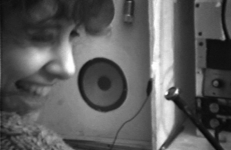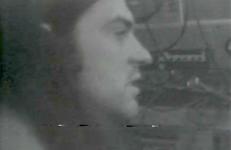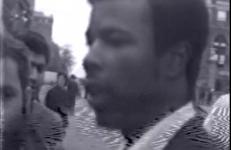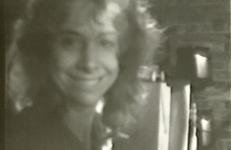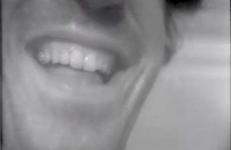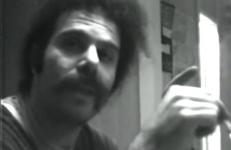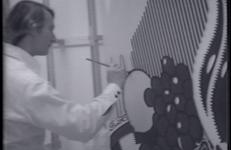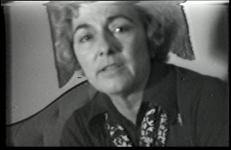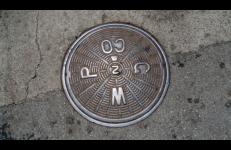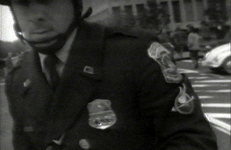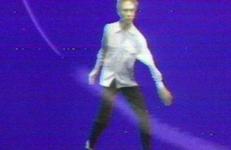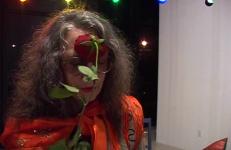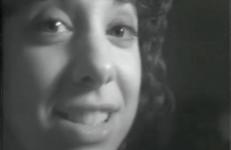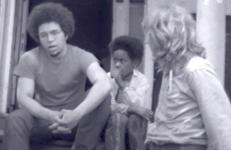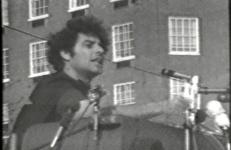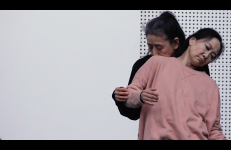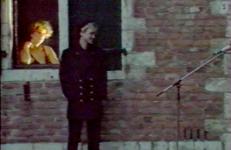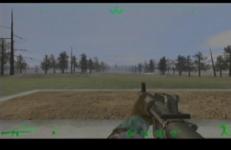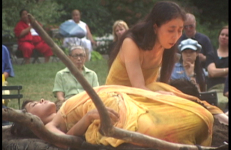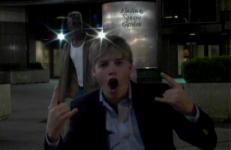"Between March 1972 and February 1977, the Videofreex aired 258 television broadcasts from a home-built studio and jerry-rigged transmitter in an old boarding house they rented in the tiny Catskill Mountain hamlet of Lanesville. It was a revolutionary act in defiance of FCC regulations — the first unlicensed TV station in America."
Documentation
Among the handful of video recordings of Lanesville TV that exist today, this tape is particularly special for its documentation of one of its very first programs to run on the air. The tape captures the energy and excitement of the Videofreex as they prepare to go live, and Parry Teasdale taking calls during the show to drum up interest and also monitor sound quality.
In this March 9th, 1974 episode of Lanesville TV, the Videofreex screen their recently shot ringside footage from a boxing match that took place over the weekend in Marion Square Gardens of nearby Tannersville, NY. The event, which pitted (volunteer wrestler-boxers) Frank “the Fist” Farkle of Haines Falls against Rocky Van Fight of Hunter in a match, was a fundraiser for the Rescue Squad of Tannersville.
In Laser Games with Shirley Clarke, the Videofreex visit the apartment of independent filmmaker Shirley Clarke. Someone brings out a laser pointer, which they then use from the top of their building to shine on the sidewalks below in an attempt to distract the passersby. After returning indoors, they experiment with optical distortion by shooting the laser directly into the camera lens while listening to psychedelic raga music.
In this video, the Videofreex host a party during which the main source of entertainment is a video-television feedback loop. In one room, a video camera linked up to a television set allows party guests to see themselves, as if in a mirror, while guests in the other room can also watch the recording, and may speak to them through a microphone. Although the voices of the off-screen guests can be heard on the tape, they are always imageless.
Timely concerns about the future of video, artists’ complicity in the money making system of the ‘establishment,’ and the effect of the camera’s presence on personal encounters, is discussed and debated in this late night video produced by David Cort, Chuck Kennedy, and Skip Blumberg.
"We are happy. (Silence.) What do we do now, now that we are happy?"
-- Samuel Beckett, Waiting for Godot
Freed intercuts still color imagery of Roy Lichtenstein’s paintings with a close quarters interview conducted in Southampton, N.Y in Summer 1972. Lichtenstein discusses the creation of his work, points of inspiration and his recurring aesthetic choices. Freed interrogates Lichtenstein’s overt references to the work of other artists in his painting, questioning his intentional evocation of cliche as he tried to define the genesis of this particular approach.
In October 1969, the Videofreex visited the home of wealthy political and social activist, Lucy Montgomery, as she was hosting the Black Panther Party of Chicago during one of their most fraught times — the period just after Chairman Bobby Seale was wrongfully imprisoned for inciting riots at the Democratic National Convention a year earlier. This particular video documents a discussion with Lucy Montgomery herself interviewed by David Cort, one of the Videofreex.
Despite assurances from local municipalities, a fact of life is that Manholes blow sky high more frequently than most people realize. Manhole 452 directs the viewer’s attention to the shapes, sizes and patterns of manhole covers on Geary Street in San Francisco, and then plunges deep below into the manholes themselves to explore the hidden threat that lies below.
Despite assurances from local municipalities, a fact of life is that Manholes blow sky high more frequently than most people realize. Manhole 452 directs the viewer’s attention to the shapes, sizes and patterns of manhole covers on Geary Street in San Francisco, and then plunges deep below into the manholes themselves to explore the hidden threat that lies below.
Shot over one day, this program records the events and protests in Washington DC on May Day, 1971. This was the day when one of the most disruptive actions of the Vietnam War era occurred in Washington, DC, when thousands of anti-war activists tried to shut down the Federal government in protest at the War.
A feel for the mood in the city is gained during the first half of the video with shots of the city from a moving car in traffic. Protestors, city residents, and police are captured on tape, along with exciting and moving shots of the day's actions and arrests.
Shot over one day, this program records the events and protests in Washington DC on May Day, 1971. This was the day when one of the most disruptive actions of the Vietnam War era occurred in Washington, DC, when thousands of anti-war activists tried to shut down the Federal government in protest at the War.
A feel for the mood in the city is gained during the first half of the video with shots of the city from a moving car in traffic. Protestors, city residents, and police are captured on tape, along with exciting and moving shots of the day's actions and arrests.
Merce by Merce by Paik is a two-part tribute to choreographer Merce Cunningham and artist Marcel Duchamp. The first section, “Blue Studio: Five Segments,” is an innovative work of video-dance produced by Merce Cunningham and videomaker Charles Atlas. Cunningham choreographed the dance specifically for the two-dimensional video monitor screen. Atlas uses a variety of video imaging effects, including chromakey, to electronically transport Cunningham’s studio performance into a series of outdoor landscapes. The audio track includes the voices of John Cage and Jasper Johns.
Linda M. Montano: 14 Years of Living Art is a video catalog of the artist’s exhibition, performance and workshop in Montreal in 2003. Produced in the context of a retrospective exhibition at the Liane and Danny Taran Gallery, the video presents a close view of Montano’s signture art/life counseling performance, interviews with participants, and views of the artworks in situ. It also documents Montano’s performance pedagogy during her all-night sleepover workshop which was collaboratively hosted by La Centrale and Rad’a.
In October 1969, the Videofreex visited the home of wealthy political and social activist, Lucy Montgomery, as she was hosting the Black Panther Party of Chicago during one of their most fraught times – the period just after Chairman Bobby Seale was wrongfully imprisoned for inciting riots at the Democratic National Convention a year earlier. This video documents an interview with the wife of Bobby Seale, Artie Seale. The video opens with a statement by Mrs.
This tape documents Nancy Cain’s birthday party and captures the inner workings of the Videofreex’s social ethos. As pipes are refilled and passed around, and the music of Aretha Franklin and the Beatles croons in the background, members of the Videofreex take turns with the camera to experiment with the effects of light, proximity, and focus in the smoke-filled room. Activity includes brief clips of a television talk show host discussing current voting turn out, longer segments of close-ups of Nancy’s face, and Parry Teasdale’s attempt to continuously blow smoke into the viewfinder.
Skip Blumberg of the Videofreex conducts an interview with Charles “Cappy” Pinderhughes, the Lieutenant of Information of the New Haven branch of the Black Panther Party. From the steps of the New Haven headquarters, Cappy publicizes the upcoming Revolutionary Peoples Constitutional Convention set to take place in Washington, D.C. later that week (June 19th, 1970). In addition, Cappy provides a statement to be shared via the Videofreex at the Alternative Media Conference occurring at Godard College in Vermont.
Footage of a May 1970 rally featuring political speakers, including members of the Black Panther Party. Abbie Hoffman talks about fighting imperialism at home, and the Chicago 7 Conspiracy Trial. As the crowd chants “Free Bobby Seale,” the Videofreex attempt to interview several National Guardsmen. We see young black men talking to the troops, with one man telling a Guardsman, “I’ve got nothing... I went to Vietnam for you."
This is a story of friendship between two independent female artists and their body memories each willingly carry. In January 2020, New York based, interdisciplinary performing artist Eiko Otake arrived in Beijing to visit Wen Hui, a Chinese choreographer and filmmaker. Eight years apart, Eiko grew up in postwar Japan and Wen during the Cultural Revolution. They planned to visit each other for a month to converse and collaborate. The surge of COVID-19 abruptly cut off Eiko's visit and the pandemic has made Wen's visit to the USA impossible but the collaboration continued.
Footage from a performance produced at Forum en Scene in Middleburg, Holland of the players continually enacting the same tasks. Nothing To Lose opens with a young, androgynous sailor standing between two buildings, while the song Nothing To Lose plays on a record player. The camera pans to two people in the national costume of Zeeland: one is peeling cucumbers and the other is washing sheets, shouting, “Good manners ruin good food.” A woman sits in her window, fingering a string of pearls and shouting to the sailor.
O.U.T. is a work documenting the emergence of computer games which train players to fight in cities among civilians, (Military Operations in Urban Terrain). O.U.T. contains sampled footage and machinima (stories told with video games) from five military simulation games. Following is a documentation of the performance, (Operation Urban Terrain), an urban wireless intervention by Anne-Marie Schleiner and an international cast of game expert and art activist collaborators.
Offering was co-commissioned by Dancing in the Streets (New York), the Walker Art Center (Minneapolis, where the proscenium version premiered January 9, 2003) and the University of Arizona (Tucson).
Offering is a ritual of regeneration after loss. People everywhere have lost ideals and landscapes that were dear to them. Offering was originally developed as a mobile outdoor work. This transportable dance or living site "installation" can be brought into communities to serve a communal need for a ritual of mourning.
While out shooting for a different project altogether, I encountered two sleeping men on a Manhattan street. A short time later, I was standing in front of Pennsylvania Train Station with the camera on a tripod, when one of the men suddenly reappeared. He stepped in front of my camera and began to speak, about his path in the U.S. military, from Panama to Afghanistan to Iraq, about his life. I decided to limit the piece to what I shot in that area in those few hours, with one key addition: the text from a classic children's rhyme.
–Jem Cohen
Are gender outlaws considered the new biological terrorists seeking weapons of mass bodily destruction? OPERATION INVERT compares the different regulations mediating botox-related plastic surgery and gender reassignment "sex change." Historical medical assessments of the invert (homosexual and transsexual) "condition" reveal seemingly outdated absurdities about outsider deviance. Nonetheless, current institutional loopholes governing gender re-assignment surgery suggest a fresh resurgence of loony pathology and diagnosis.




